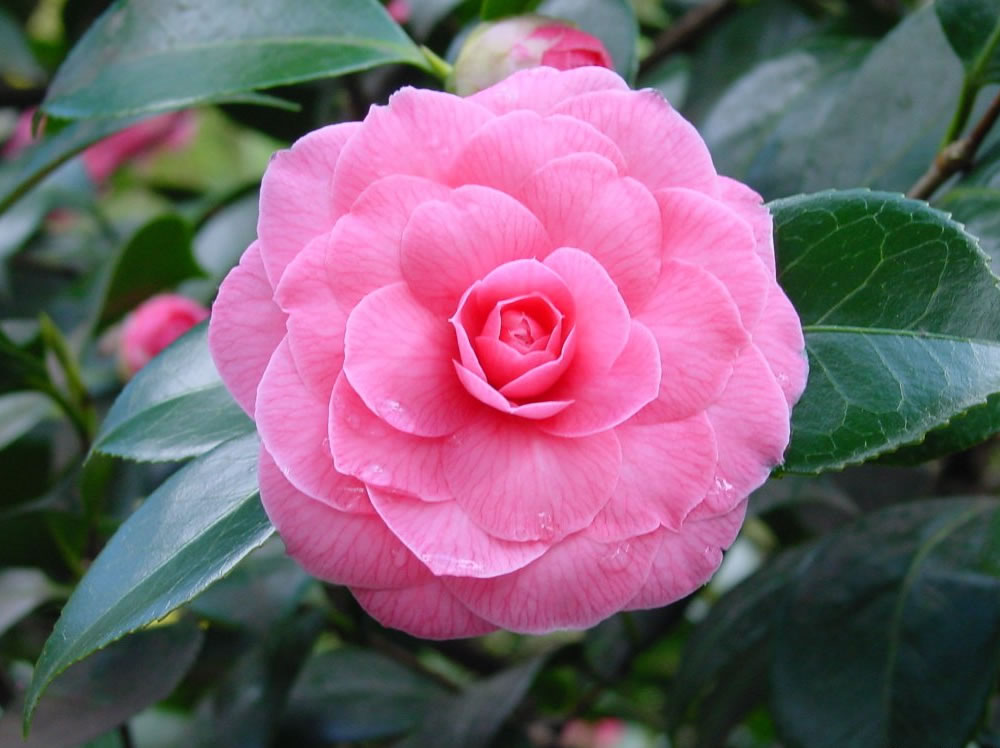Camellia
Tea plant (Camellia sinensis)
The Camellia (Camellia ) is a plant genus of the family of Teestrauchgewächse ( Theaceae ). This genus consists of about 200 to 300 species of plants, including the famous Camellia japonica. The original naming by Carl Linnaeus in honor of Father Georg Joseph Kamel, who brought the C. japonica from Manila to Spain.
Description
Camellias are evergreen trees or shrubs. The alternate and spirally arranged on the branches leaves are leathery and easy. Usually a petiole is present, the leaf margin is usually serrate, rarely smooth, stipules absent.
The hermaphrodite flowers are single or at most threes in the leaf axils. Flower stems are medium or missing. There are two or more bracteoles they have become obsolete or subject to change and are difficult to distinguish from the sepals. The usually five or rarely six to ten sepals are fused weak at their base. The usually five to eight (rarely up to twelve) petals are fused more or less at the base. The many stamens are in two to six counties. The outermost stamen circle has grown to its lower half of the petals, the stamens can be fused into a tube, the anthers are more or less attached to their approach to the stamens. The upper constant ovary is three to fünffächrig, with one to two, rarely up to ten ovules per carpel. The style is simple or branched, or consists of non- adult pen branches.
The capsule fruit the calyx on fruit set is retained, he rarely drops. The seeds are almost round and wingless. The embryo is straight. The fleshy, semi-circular cotyledons contain a lot of oil.
Dissemination
The genus is restricted to East Asia and spread to Indomalesien. Center of biodiversity is southern China.
System
The genus consists of 100 to 300 species, it is divided into four subgenera and 20 sections:
- Subgenus Protocamellia
- Camellia subgenus
- Subgenus Metacamellia
- Subgenus Thea
Of particular economic importance are:
- Tea ( Camellia sinensis ( L.) Kuntze )
- Camellia japonica L.
- Camellia kissi Wall.
- Camellia oleifera Abel C.
- Camellia reticulata Lindl.
- Camellia saluenensis Stapf ex Bean
- Camellia sasanqua Thunb.
Other types (selection):
- Camellia petelotii ( Merr. ) Sealy.
Use
The best-known species of the genus is the tea plant, and also of a few other species, the leaves are used to Teegewinnung. Some species and many hybrids are used as ornamental plants. There are a number of types which are used for the production of camellia oil. There are also species with edible flowers. In the Japanese tea ceremony ( wabi chan) next to the leaves of camellia blossoms ( tsubaki ) are used for decoration in the Tokonoma, especially during the flowering season in spring. A very popular variety is C. japonica ' Shiratama ', but also ' Kamohonami ' is often taken.
Evidence
- P.F. Stevens, S. Dressler, A. L. Weitzman: Theaceae. In: Klaus Kubitzki (ed.): The Families and Genera of Vascular Plants. Volume 6: Flowering Plants, Dicotyledons: Celastrales, Oxalidales, Rosales, Cornales, Ericales. Springer, Berlin / Heidelberg / New York 2004, ISBN 3-540-06512-1, pp. 463-471, doi: 10.1007/978-3-662-07257-8 ( limited preview on Google Book Search ).










